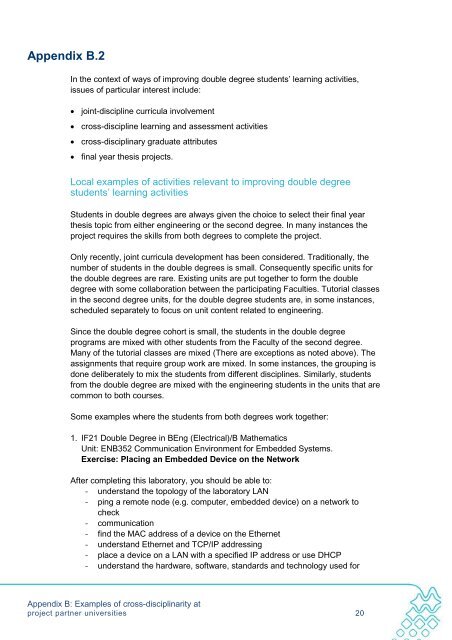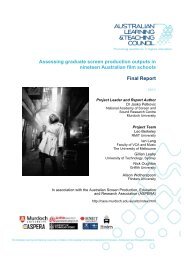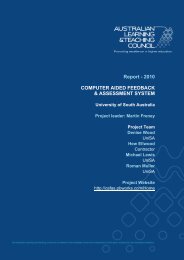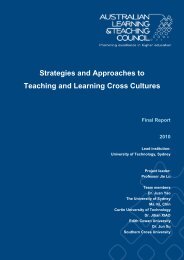Download Document - Office for Learning and Teaching
Download Document - Office for Learning and Teaching
Download Document - Office for Learning and Teaching
You also want an ePaper? Increase the reach of your titles
YUMPU automatically turns print PDFs into web optimized ePapers that Google loves.
Appendix B.2<br />
In the context of ways of improving double degree students’ learning activities,<br />
issues of particular interest include:<br />
• joint-discipline curricula involvement<br />
• cross-discipline learning <strong>and</strong> assessment activities<br />
• cross-disciplinary graduate attributes<br />
• final year thesis projects.<br />
Local examples of activities relevant to improving double degree<br />
students’ learning activities<br />
Students in double degrees are always given the choice to select their final year<br />
thesis topic from either engineering or the second degree. In many instances the<br />
project requires the skills from both degrees to complete the project.<br />
Only recently, joint curricula development has been considered. Traditionally, the<br />
number of students in the double degrees is small. Consequently specific units <strong>for</strong><br />
the double degrees are rare. Existing units are put together to <strong>for</strong>m the double<br />
degree with some collaboration between the participating Faculties. Tutorial classes<br />
in the second degree units, <strong>for</strong> the double degree students are, in some instances,<br />
scheduled separately to focus on unit content related to engineering.<br />
Since the double degree cohort is small, the students in the double degree<br />
programs are mixed with other students from the Faculty of the second degree.<br />
Many of the tutorial classes are mixed (There are exceptions as noted above). The<br />
assignments that require group work are mixed. In some instances, the grouping is<br />
done deliberately to mix the students from different disciplines. Similarly, students<br />
from the double degree are mixed with the engineering students in the units that are<br />
common to both courses.<br />
Some examples where the students from both degrees work together:<br />
1. IF21 Double Degree in BEng (Electrical)/B Mathematics<br />
Unit: ENB352 Communication Environment <strong>for</strong> Embedded Systems.<br />
Exercise: Placing an Embedded Device on the Network<br />
After completing this laboratory, you should be able to:<br />
- underst<strong>and</strong> the topology of the laboratory LAN<br />
- ping a remote node (e.g. computer, embedded device) on a network to<br />
check<br />
- communication<br />
- find the MAC address of a device on the Ethernet<br />
- underst<strong>and</strong> Ethernet <strong>and</strong> TCP/IP addressing<br />
- place a device on a LAN with a specified IP address or use DHCP<br />
- underst<strong>and</strong> the hardware, software, st<strong>and</strong>ards <strong>and</strong> technology used <strong>for</strong><br />
Appendix B: Examples of cross-disciplinarity at<br />
project partner universities 20

















